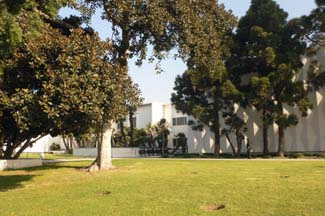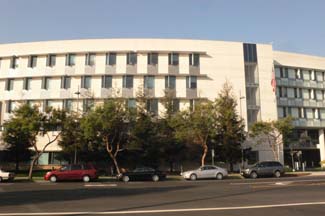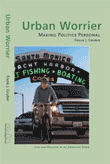By Frank Gruber
Who knows if the City of Santa Monica will make a deal with Eli
and Edythe Broad to locate a museum for their collections of contemporary
art at the Santa Monica Civic Center. Amid the enthusiasm I've
also heard skepticism.
But outgoing City Manager Lamont Ewell is conducting negotiations,
and the City Council is having closed sessions to discuss those
negotiations, and so now is the time (for me, anyway) to try to
influence those negotiations.
Although the Broads and the City will not design the museum in
these negotiations, there are urban design issues that the City
should be sure to address in a deal. The proposed location for
the museum, on Main Street between the Civic Auditorium and the
courthouse, is an important one, but one that at the present time
hardly reaches its potential.
Members of the City Council and other officials often refer to
the Civic Center as Santa Monica's "heart," but if it
were the city would be on the brink of a coronary. The Civic Center
is the dullest public space in Santa Monica.
|
Main Street
in the Civic Center-looking north (Photos by Frank Gruber) |
The Civic Center is living evidence of the bankruptcy of urban
design and theory in the mid-20th century: in the middle of a
vibrant city, where there once was a transit hub and a neighborhood
of homes and businesses, planners plopped down a suburban office
park of banal public buildings.
With the Civic Center Specific Plan of 1993 and its subsequent
revisions, the City attempted to return life back to the area,
but so far the results have been meager. Two major buildings have
been built under the plan -- the City's Public Safety Building
and the new RAND building -- but neither contributes much sidewalk
ambiance. There is more potential if the "Village" developments
along Ocean Avenue can be built, but they now seem doubtful because
of financing problems.
There are few reasons for people who don't work in the Civic
Center to visit the area unless they have business at City Hall
or RAND, a court case to attend to, or want to attend a gem show
or similar event at the Civic, and that's why you see so few people
walking on Main Street north of Pico.
The strongly beating "hearts" of Santa Monica are downtown
and the Pier, crowded with tens of thousands of residents and
visitors per day and many millions per year. The pulse beats quicker
than it does in the Civic Center even in neighborhood centers
like Main Street in Ocean Park, Montana Avenue, the eastern stretch
of Pico, or Wilshire around 11th Street.
And then there is the architecture of the Civic Center. The new
museum would be sandwiched between two ugly -- when judged by all
four of their sides -- mid-century modern buildings, the courthouse
and the Civic Auditorium. Those two are exceptionally uninspiring
in and of themselves, but all the nearby buildings -- regardless
of their own qualities -- ignore Main Street.
Here is the side of the auditorium facing Main Street (the side
that faces Pico is even worse)
|
The Civic
Auditorium ignoring Main Street |
Here is the courthouse, viewed from Main Street
|

|
The courthouse
and its suburban front yard |
Here is the back of the Viceroy Hotel, across the street from the
museum site
|
The Viceroy's
hotel spite-hedge; perhaps the hotel could re-orient itself
to connect to a museum |
|
Here is the front of the new RAND building.
 |
| RAND in its entrance tried
to do better, but what's stopping RAND from putting a bench
or two in their front yard? |
I don't necessarily blame the designers of these buildings, especially
those that came later in the process. It's hard to try to turn a
barren streetscape into something congenial all on your own.
But a museum is a special case and would present a special opportunity.
In the medieval city, cathedrals and churches defined public spaces;
art museums are the cathedrals and churches of our time. In diverse
societies, art is a secular religion that nearly all the populace
can believe in. Cities around the world have used museums to establish,
mark and define public space.
According to the City staff's report on the authorization to negotiate
with the Broads, they want the right to name the museum's architect.
Fair enough -- history gives us no definitive reason to believe
that a public process will select a better architect than individual
patrons. But the City must insist that along with the Broads, the
City will be an equal client dealing with the architect for the
design of how the museum interacts with the public realm.
The museum must, at a minimum, be a "four-sided" building
-- a building that like a medieval cathedral presents at least a
welcoming, if not actually open, visage in all directions. If this
sounds basic, consider three iconic buildings built in recent years
in downtown Los Angeles: Walt Disney Hall, by Frank Gehry, the Caltrans
building, by Thom Mayne, and the new Cathedral by Rafael Moneo.
(In a relevant aside, Messrs. Gehry and Mayne are both Pritzker
Prize winning architects who live in Santa Monica; with respect
to the Broad Museum, the former seems to be a popular favorite in
Santa Monica to receive the commission, while according to rumors
the Broads have already picked the latter.)
Disney Hall, Caltrans and the Cathedral are stunning buildings,
but there is only one streetscape between the three of them that
works -- that of Disney Hall along Grand Avenue (recently further
enlivened with outdoor dining). Messrs. Mayne and Moneo designed
plazas for their buildings (that of the Cathedral is, at least,
inviting), but both are cut off from the street -- the one at Caltrans
by changes in elevation and other obstacles that obscure the view
of the plaza from First Street, and the one at the Cathedral by
a wall.
Meanwhile, all three architects appear to have given little thought
to the backs and sides of their buildings. It's true that the Cathedral
site abuts a freeway, and one could not expect much in that direction,
and that the back of Disney faces a viaduct, but, for example, did
Mr. Gehry have to stick a plain metal service door in the middle
of the façade of Disney that faces the Music Center across
First Street?
|
| First Street façade
of Walt Disney Hall |
For Santa Monica, all of this is important, because while on one
side the museum will face Main Street, on at least one and perhaps
two other sides it will face the park that the City plans to build
on the Civic Auditorium's parking lots. (Let me say again, as I
have written before in the column Don't
Forget_the_History, February, 13, 2006, that this park
should as part of its mission commemorate and be named for the Belmar
Place Triangle neighborhood that the City destroyed to build the
Civic.)
If the City makes the deal for the museum, the museum and the park
need to be designed together, and in turn, these designs will have
implications for the whole Civic Center plan, including as it relates
to plans for Santa Monica High School.
Let's hope we have these issues to deal with.
Frank
J. Gruber is the author of Urban Worrier: Making Politics Personal,
available at Hennessey + Ingalls and Angel City books in Santa Monica,
at City Image Press, and on amazon.com.
| Hear Mr.
Gruber speak at the Santa Monica Library, December 10, 2009.
More
info. |
 |
"
Urban Worrier " an Inside Look at Life and Politics
in an American Town |
|
|




